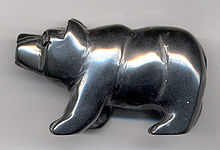Detailed Information about Magnetism of hematite

Hematite carving, 5 cm (2 in) long
Hematite is an antiferromagnetic material below the Morin transition at 250 K, and a canted antiferromagnet or weakly ferromagnetic above the Morin transition and below its Néel temperature at 948 K, above which it is paramagnetic.
The magnetic structure of a-hematite was the subject of considerable discussion and debate in the 1950s because it appeared to be ferromagnetic with a Curie temperature of around 1000 K, but with an extremely tiny moment (0.002 µB). Adding to the surprise was a transition with a decrease in temperature at around 260 K to a phase with no net magnetic moment. It was shown that the system is essentially antiferromagnetic but that the low symmetry of the cation sites allows spin–orbit coupling to cause canting of the moments when they are in the plane perpendicular to the c axis. The disappearance of the moment with a decrease in temperature at 260 K is caused by a change in the anisotropy which causes the moments to align along the c axis. In this configuration, spin canting does not reduce the energy.
Hematite is part of a complex solid solution oxyhydroxide system having various degrees of water, hydroxyl group, and vacancy substitutions that affect the mineral's magnetic and crystal chemical properties. Two other end-members are referred to as protohematite and hydrohematite.
Iron from mine tailings
Hematite is present in the waste tailings of iron mines. A recently developed process, magnetation, uses huge magnets to glean waste hematite from old mine tailings in Minnesota's vast Mesabi Range iron district.
- Introduction of gold trommel machine
- Mill balls and water influence the effic
- Fault handling of jaw crusher
- process of Stone Aggregates produced by
- How to maintain ball mill with the lubri
- China mining machinery need technology i
- How to choose jaw crusher--let me help y
- Domestic Mining Machinery Trends brief a
- The future development trends and prospe
- The development of ball miller feeding
- Songling advise for the purchase skills
- Mining mechanization hot ascension of Mi
- The property of Flotation Machine
- The Most Important Factor in the Process
- Obvious advantages of ball mill
- Environmental Protection Idea must be st
- The Benefits of central bank cutting int
- Stone production industry promote the c
- The future of the drying equipment in Ch
- Rock Crusher Maintenance

 Jenny
Jenny